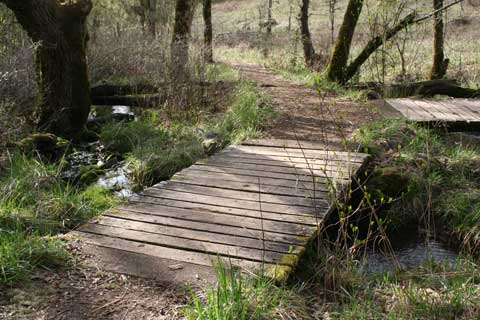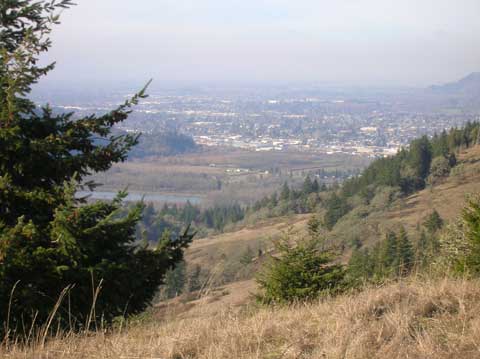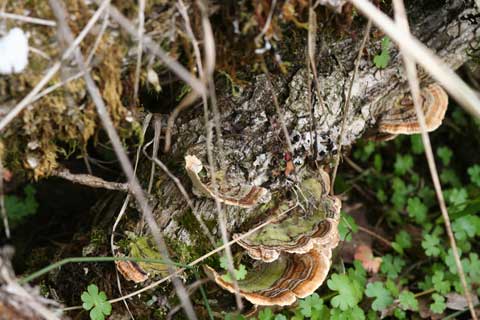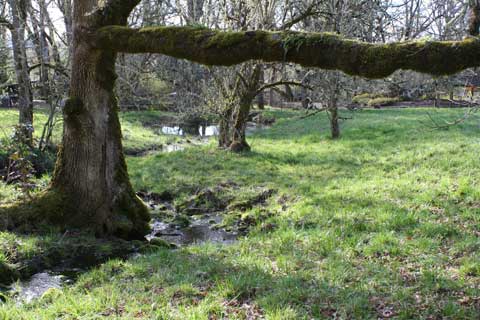Forest wondersA 200+ acre preserve just outside Eugene offers miles of secluded hiking trails through pristine ecosystems of the Willamette Valley.
by Teresa StanonikAmong the many outdoor adventures offered by the rugged and varied geography of the Willamette Valley, there are few activities that rival a day at Mount Pisgah Arboretum. Located only 7 miles east of Eugene, this natural preserve is highly popular with local residents and tourists. Those who frequent the park know the many intersecting hiking trails of the mountain – ones that lead to hidden streams, highland prairies, mature conifer forests, secret gardens and breathtaking views that overlook the valley. Equestrians, dog-owners, athletes, bird-watchers and families all enjoy the outdoor wonders at Mount Pisgah Arboretum. Trails & AttractionsThe 209-acre arboretum boasts 7 miles of neatly maintained hiking trails with many bridges and benches, forested picnic areas, healthy groves of Oregon white oak, Douglas fir and cedar, and rhododendron and water gardens. There are labyrinths of meandering side paths through the forests and meadows that shadow the main trails, allowing jaunts through different ecological zones such as marsh land or hillside prairie. It is easy to disappear on these paths but not get lost. The park borders the Coast Fork of the Willamette River and tributaries etched into the mountainside meander down to meet it, crossing across and under the trails at various locations.  Slide Show: Trails through the scenery of Mount Pisgah Most trails around Mount Pisgah lead to the 1500-foot summit, a wind-swept overlook affording expansive views of the Willamette Valley, Eugene-Springfield, the western Coast Range mountains and the eastern Cascade mountains. While many visitors come to hike to the top, many others visit simply to explore the preserve and learn more about Oregon’s native ecosystems. Facilities, Families & FestivalsEugene native Stephanie Kessler has been visiting Mount Pisgah Arboretum since age 7. It was a favorite picnic spot to go with her parents, who often packed enough supplies to sustain Kessler and her five siblings for a whole day at the park. “We’d get here in the late morning and stay until sunset,” recalls Kessler with a twinkle of nostalgia in her eyes. “I remember collecting turtles from the stream with my brothers and wandering through the woods. Everything seemed so big and magical then.” Kessler now brings her own family to Mount Pisgah to enjoy the “magic” that can be found outdoors. “Sometimes we’re ambitious and hike to the top,” she says of her husband and three children, “but usually we hang out in the meadow by the stream. We like to bring our dog and a Frisbee, and picnic.” Many families like Kessler’s take advantage of the arboretum, which gives kids a space to run around and play. Other individuals enjoy the visitor’s center interpretive nature walks and craft workshops. The park also has an educational center that offers an environmental program for grade school students.  Slide Show: Park Facilities and Ecology Favorites among locals and tourists are Mount Pisgah’s yearly Wildflower Festival in May and Mushroom Festival in October. Both shows started in 1981, and every year draw a hoard of wildlife enthusiasts to the colorful events and lectures. An onsite pavilion hosts these gatherings, the Q Hut, which also is available to the public to rent for large parties. Wildlife: PlantsMount Pisgah Arboretum is celebrated a “living tree museum.” It harbors approximately 100 species of wooded plants and about 240 species of fern, brush, shrub, sedge, grass, clover, moss, nettle, herb and wildflower. The park is also well-known for its diversity of fungi and lichen. A walk down one of the many trails at the arboretum demonstrates the beauty of all these plant elements living in natural harmony. Indeed, the preserve houses some of the most pristine prairie, wetland and oak savanna ecosystems of the Willamette Valley, according to local biologists.  Slide Show: Oak Savanna and Sandalwood Habitats The park sustains these ecosystems with care. While some areas are left untouched, other environments are maintained to promote the growth of native plants. The Oregon white oak savanna habitats are carefully controlled by the arboretum, which posts signs along the trails to explain the methods and goals utilized in these areas. Another maintained environment is the incense cedar forest, where the fragrant trees are allowed the room they need to grow to large and twisted proportions. Information pertaining to plant and tree species as well as park practices is displayed throughout Mount Pisgah Arboretum. Wildlife: AnimalsIn tune with the healthy plant life at Mount Pisgah is an abundance of animal and insect life. Fox, coyote, deer, lizards, snakes, frogs, bats, falcons, eagles, hawks, woodpeckers, finches and swallows are but a few of the more popular animals you may spot. For those who love insects there is spring, when dragonflies, beetles and butterflies abound. Of particular note is the prolific and varied bird population at Mount Pisgah. While there I witnessed a peregrine falcon glide effortlessly in the wind currents above the wild grasslands on the prowl for a lunchtime snack. Five minutes of wide-swept circles around the prairie, with the occasional quick, light swoop down close to the ground, yielded this hunter a lively treat from the shrubs. When the falcon sighted its target it hovered for what seemed an eternity, and then in one smooth motion to the left vertically dive-bombed its prey. Feathered moments and a few victorious screeches later, the peregrine was off high above the grassland, a tiny bird clamped tightly in one claw, headed toward the cover of forest. As I watched the peregrine retreat, I felt grateful for my good luck, but knew this cycle-of-life activity was an everyday occurrence at Mount Pisgah Arboretum. |
